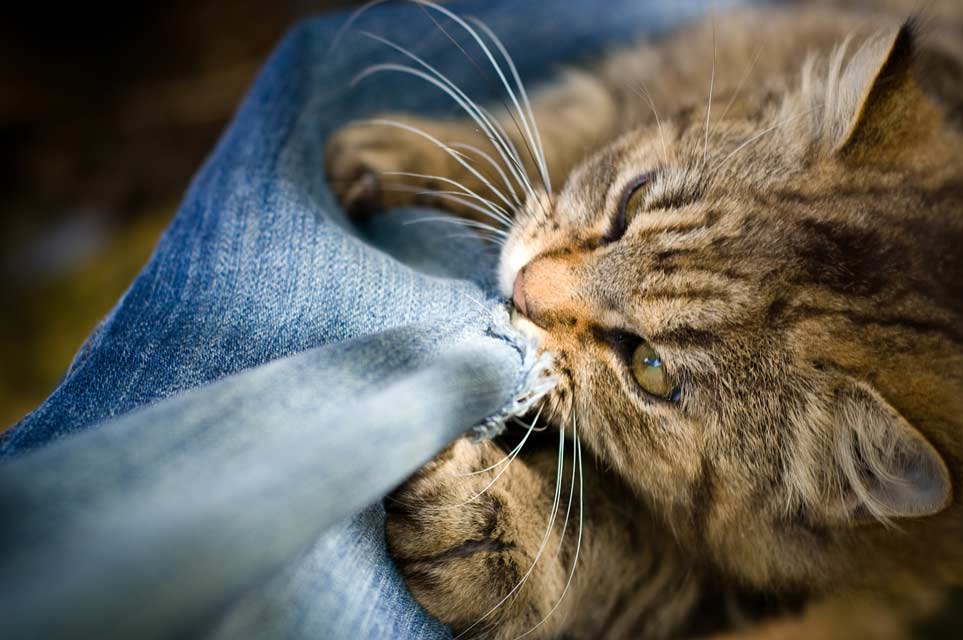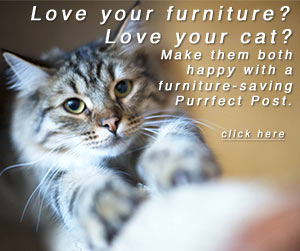Pica in Cats: Why Cats Eat Strange Things

Pica in cats is the regular eating of non-food items. Plastic, cotton, paper, cords, and shoelaces are all common targets of cats with pica. It can be very dangerous for a cat to engage in pica because non-food items can cause choking, GI upset, and intestinal obstruction that may require surgery.
Pica is considered an obsessive-compulsive disorder in cats. This means that it is a repetitive, uncontrollable impulse.
It's important to note that not all cats that chew or eat non-food items have pica. Especially in the case of kittens, cats may just be experimenting or playing with an item. Pica refers to a long-term habit, not a one-time incident.
Pica is more common in Oriental cat breeds, especially Siamese. This indicates that there may be a genetic component to the likelihood of a cat developing pica. It is also possible that this over-representation of Siamese cats has to do with their sensitive nature, since many cases of pica are triggered by stress.
Causes of Pica in Cats
If your cat is eating non-food items regularly, medical causes of pica must be explored first, through a visit to your veterinarian. Pica may begin as a medical issue but become a habit if it goes on for too long before it is treated. Some medical problems that sometimes cause pica in cats are:
- Diabetes
- Brain tumors
- Anemia
- Feline Leukemia Virus and FIV: Feline Immunodeficiency Virus, both immunodeficiency viruses
- Dental disease
- Hyperthyroidism
Stressful situations may serve as triggers for cats to begin engaging in pica. These can include:
- Lack of attention: If your cat is not getting enough interaction with you and he receives a reaction (even a negative one) for the pica behavior, he may continue to do it in order to receive the interaction time with you.
- Misdirected behavior: A cat may resort to pica when he really wants to do something else but can't.
- Cats in the yard: If your cat sees another cat in the yard through the window, he may want to chase, fight with, or play with it. He may become frustrated because he can't reach the other cat and begin tearing into a toy instead. If this happens enough times, it may become a habit that no longer requires the inciting cause of seeing another cat in the yard.
- Separation anxiety: Cats that get upset when their owner leaves the house may develop a variety of negative behaviors, including pica.
- Not enough play (boredom): Cats may be eating non-food items out of lack of stimulation and play time. Pica can be a form of self-stimulation to relieve boredom.
- Loud noises: Cats may use pica as stress relief if there are loud noises in the house that upset them. This could be loud music, instrument practicing, construction noise, or frequent parties.
- A move: Moving to a new home may trigger stress-related pica in cats.
- New people or someone has left: Pica may develop if a cat is upset about a new person or animal in the home, or if one has left the home or died.
Other considerations for pica in cats:
- Many experts believe that pica is more common in cats that were weaned from their mothers too early.
- Wool-sucking (a behavior that mimics nursing on fabric, peoples' hair, skin, or earlobes) and compulsive fur-licking are other obsessive disorders in cats. Wool-sucking in a kitten can sometimes progress to pica as the cat gets older.
- If a cat is tearing up, but not eating items such as stuffed animals and blankets, it may be related to his predatory instinct. Your cat may be imitating the natural behavior of tearing the feathers from a killed bird by tearing up items.
How to Treat Pica in Cats
Treatment for feline pica depends on the cause. Some treatment possibilities include:
-
Desensitization therapy: This is the process of redirecting your cat's unwanted behavior into a more positive activity.
- As much as is possible, remove the inappropriate items that your cat eats from his reach.
- Do not react either negatively or positively when you see your cat engaging in the pica behavior. Simply remove the item that he is eating.
- Redirect your cat to a more positive behavior. Give your cat an appropriate toy to chew on or activity to do instead of eating the non-food item. Give him lots of praise or treats when he does what you want him to do.
-
Provide alternative activities for your cat to engage in. The most effective of these are:
- Play: Make sure that you play with your cat at least once a day.
- Provide toys that are made of a material that is different than the one your cat eats. This may mean using rubber or plastic toys rather than fabric or stuffed toys.
-
Provide lots of different toys for your cat to play with that combat boredom and stress.
- DIY toys: It can be easy and fun to make your own cat toys at home.
- Toys that mimic prey: These can be especially helpful in combatting stress in cats, as they are predators at heart. Toys that "fly" and "scurry" can help a cat relieve stress through "hunting."
- Walks outside: Some cats love to go for walks outside with a leash and harness. Take your cues from your cat as to whether or not he enjoys this. If he does, it can be a good stress-reliever for both of you.
- Catnip plants or cat grass in the house can provide a safer substitute for your cat to eat.
-
Plan enrichment activities for your indoor cat:
- Puzzle toys are a great way for your cat to keep busy and mentally stimulated when you aren't home.
- Rather than placing all of your cat's food in a large bowl in the same spot all of the time, divide it into several small bowls and hide them around the house. This will allow your cat to "hunt" for his food and help keep him busy and stimulated.
- Kongs with kibbled cat food inside are another way to keep your cat occupied and happy. You can use a small dog Kong if necessary.
-
Deterrents
- Bad-tasting sprays applied to your cat's target items, when they cannot be removed entirely, may deter him from chewing on them.
- Feliway: This product mimics the natural feline calming pheromone. It comes in sprays and diffusers, and it may be able to help relieve your cat's stress and decrease his pica. You can read more about Feliway and why it is useful for treating stress in cats here: "Feliway - A Useful Tool to Help Treat Stress in Cats."
-
Keeping other cats out of your yard: If you suspect that your cat is experiencing anxiety because of stray or neighborhood cats entering your yard, you can try to make your yard uninviting to feline interlopers.
- Install motion-detecting sprinklers. Cats that enter your yard won't want to stay if they are suddenly sprayed with water.
- Install a motion-detecting ultrasonic sound machine. These devices emit a noise that humans can't hear but cats can. Cats will usually want to avoid an area where this type of sound is present.
- Medications: Some cats require medications for their obsessive pica. Anti-anxiety medications can be helpful in some of these cases and are even more helpful when they are used in conjunction with behavior modification and desensitization. Never give your cat any medications that were not prescribed by your veterinarian. Human medications can be extremely dangerous to cats.
Although pica can be a frustrating problem for cat owners, it is important that you never use punishment to deal with it. This can cause your cat to experience more stress and anxiety and make the problem worse.
You May Also Like These Articles:
How to Play With Your Cat- Part One
Keeping Your Cat Active While You're Away
Notice: Ask-a-Vet is an affiliated service for those who wish to speak with a veterinary professional about their pet's specific condition. Initially, a bot will ask questions to determine the general nature of your concern. Then, you will be transferred to a human. There is a charge for the service if you choose to connect to a veterinarian. Ask-a-Vet is not manned by the staff or owners of CatHealth.com, and the advice given should not delay or replace a visit to your veterinarian.





